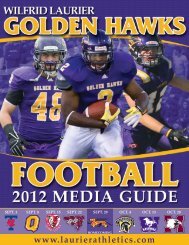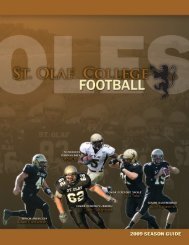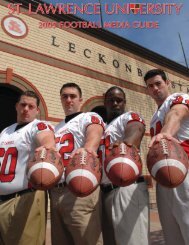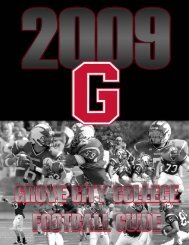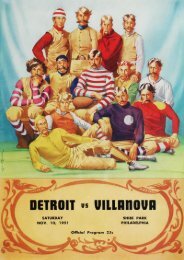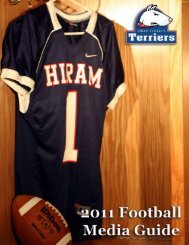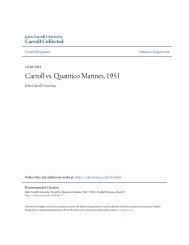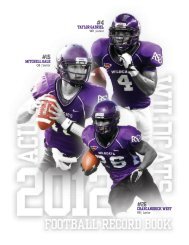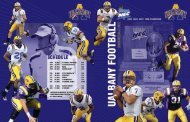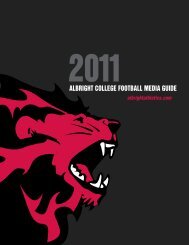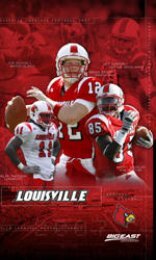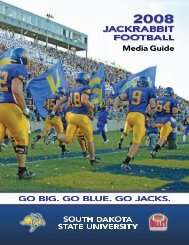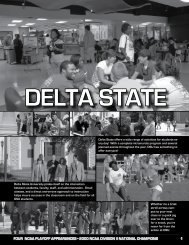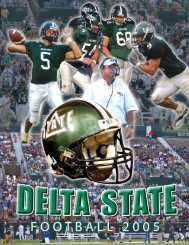BUFFALO BITS 2004 SCHEDULE - Collegefootballdatadvds.com
BUFFALO BITS 2004 SCHEDULE - Collegefootballdatadvds.com
BUFFALO BITS 2004 SCHEDULE - Collegefootballdatadvds.com
You also want an ePaper? Increase the reach of your titles
YUMPU automatically turns print PDFs into web optimized ePapers that Google loves.
therapeutic application.<br />
Humerus — Bone of the upper arm that runs from<br />
the shoulder to the elbow.<br />
Hydrotherapy — Treatment using water.<br />
Hyperextension — Extreme extension of a limb or<br />
body part.<br />
Iliotibial Band — A thick, wide fascial layer that<br />
runs from the iliac crest to the knee joint and is<br />
occasionally inflamed as a result of excessive<br />
running.<br />
Inflammation — The body’s natural response to<br />
injury in which the injury site might display various<br />
degrees of pain, sweating, heat, redness,<br />
and/or loss of function.<br />
Internal Rotation — Rotation of a joint or extremity<br />
medially, to the inside.<br />
Lesion — Wound, injury or tumor.<br />
Ligament — Band of fibrous tissue that connects<br />
bone to bone or bone to cartilage and supports<br />
and strengthens joints.<br />
Lumbar Vertebrae — Five vertebrae of the lower<br />
back that articulate with the sacrum to form the<br />
lumbosacral joint<br />
Magnetic Resonance Imaging (MRI) — Imaging<br />
procedure in which a radio frequency pulse<br />
causes certain electrical elements of the injured<br />
tissue to react to this pulse and through this<br />
process a <strong>com</strong>puter display and permanent film<br />
establish a visual image. MRI does not require<br />
radiation and is very useful in the diagnosis of soft<br />
tissue, disc, and meniscus injuries.<br />
Meniscectomy — An intra-articular surgical procedure<br />
of the knee by which all or part of the damaged<br />
meniscus is removed.<br />
Meniscus — Crescent shaped cartilage, usually<br />
pertaining to the knee joint; also known as “cartilage.”<br />
There are two menisci in the knee, medial<br />
and lateral. These work to absorb weight within<br />
the knee and provide stability.<br />
Metacarpals — Five long bones of the hand, running<br />
from the wrist to the fingers.<br />
Metatarsals — Five long bones of the foot, running<br />
from the ankle to the toes.<br />
Myositis — Inflammation of a muscle.<br />
Necrotic — Relating to death of a portion of tissue.<br />
Neoprene — Lightweight rubber used in joint and<br />
muscle sleeves designed to provide support<br />
and/or insulation and heat retention to the area.<br />
Neuritis — Inflammation of a nerve.<br />
Orthotic — Any device applied to or around the<br />
body in the care of physical impairment or disability,<br />
<strong>com</strong>monly used to control foot mechanics.<br />
Parasthesia — Sensation of numbness or tingling,<br />
indicating nerve irritation.<br />
Patella — The kneecap. The patella functions to<br />
protect the distal end of the femur as well as<br />
increase the mechanical advantage and force generating<br />
capacities of the quadriceps muscle group.<br />
Patella Tendinitis — Inflammation of the patella<br />
ligament; also known as “jumpers knee.”<br />
Patellofemoral Joint — Articulation of the knee<br />
cap and femur. Inflammation of this joint can occur<br />
through: 1) acute injury to the patella, 2) overuse<br />
from excessive running particularly if there is an<br />
associated knee weakness, 3) chronic wear and<br />
tear of the knee, 4) as a result of poor foot mechanics.<br />
Patellofemoral irritation can lead to chondromalancia,<br />
which in its most chronic condition,<br />
could require surgery.<br />
Peroneal Muscles — Group of muscles of the lateral<br />
lower leg that are responsible for everting the<br />
knee. Tendons of these three muscles are vital to<br />
the stability of the ankle and foot.<br />
Phalanx — Any bone of the fingers or toes; plural<br />
is phalanges.<br />
Phlebitis — Inflammation of a vein.<br />
Plica — Fold of tissue in the joint capsule and a<br />
<strong>com</strong>mon result of knee injury.<br />
Posterior Cruciate Ligament (PCL) — A primary<br />
stabilizing ligament of the knee that provides significant<br />
stability and prevents displacement of the<br />
tibia backward within the knee joint. A <strong>com</strong>plete<br />
tear of this ligament necessitating reconstruction<br />
could require up to 12 months of rehabilitation.<br />
Quadricep Muscles “Quads” — A group of four<br />
muscles of the front thigh that run from the hip<br />
and form a <strong>com</strong>mon tendon at the patella; they are<br />
responsible for knee extension.<br />
Radiography — Taking of X-rays.<br />
Radius — Forearm bone on the thumb side.<br />
Reconstruction — Surgical rebuilding of a joint<br />
using natural, artificial or transplanted materials.<br />
Referred Pain — Pain felt in an undamaged area of<br />
body away from the actual injury.<br />
Retraction — The moving of tissue to expose a<br />
part or structure of the body.<br />
Rotator Cuff — Comprised of four muscles in the<br />
shoulder area that can be irritated by over use.<br />
The muscles are the supraspinatus(most <strong>com</strong>monly<br />
injured), infraspinatus, teres minor, and<br />
subscapularis.<br />
Rotator Cuff Impingement Syndrome — A microtrauma<br />
or overuse injury caused by stress, and the<br />
four stages are: 1) Tendentious with temporary<br />
thickening of the bursa and rotator cuff; 2) Fiber<br />
dissociation in the tendon with permanent thickening<br />
of the bursa and scar formation; 3) A partial<br />
rotator cuff tear of less than one centimeter; and<br />
4) A <strong>com</strong>plete tear of one centimeter or more.<br />
Sacrum — Group of five fused vertebrae located<br />
just below the lumbar vertebrae of the low back.<br />
Scapula — Shoulder blade.<br />
Sciatica — Irritation of the sciatic nerve resulting<br />
in pain or tingling running down the inside of the<br />
leg.<br />
Sciatic Nerve — Major nerve that carries impulses<br />
for muscular action and sensations between the<br />
low back and thigh and lower leg; it is the longest<br />
nerve in the body.<br />
Shin Splint — A catch-all syndrome describing<br />
pain in the skin that is not a fracture or tumor and<br />
cannot be defined otherwise.<br />
Sorbothane — An energy absorbing polyurethane<br />
utilized in some foot orthotics to absorb shock<br />
forces of the foot.<br />
Spasm (Theory) — Muscle soreness induced by<br />
exercise; is the result of reduced muscle blood<br />
flow, which results in pain.<br />
Spleen — Large, solid organ responsible for the<br />
normal production and destruction of blood cells.<br />
Spondylitis — Inflammation of one or more vertebrae.<br />
Spondylolisthesis — Forward displacement of<br />
one vertebrae over another below it due to a<br />
developmental defect in the vertebrae.<br />
Spondylosis — Abnormal vertebral fixation or<br />
immobility.<br />
Sprain — Injury resulting from a stretch or twist of<br />
the joint and causes various degrees of stretch or<br />
tear of a ligament or other soft tissue at the joint.<br />
Sternum — The breast bone.<br />
Steroids — Any one of a large number of hormonelike<br />
substances. See Anabolic steroids and cortical<br />
steroids.<br />
Strain — Injury resulting from a pull or torsion to<br />
the muscle or tendon that causes various degrees<br />
of stretch or tear to the muscle or tendon tissue.<br />
Stress Fracture — A hair-line type of break in a<br />
bone caused by overuse.<br />
Stress X-ray — A continual X-ray taken when a portion<br />
of the body is stressed to its maximum in<br />
order to determine joint stability. This is a test utilized<br />
in some ankle injuries.<br />
463<br />
Stretching — Any therapeutic maneuver designed<br />
to elongate shortened soft tissue structures and<br />
thereby increase flexibility.<br />
Subluxation — Partial dislocation of a joint. The<br />
term usually implies that the joint can return to its<br />
normal position without formal reduction.<br />
Talus — The ankle bone that articulates with the<br />
tibia and fibula to form the ankle joint.<br />
Target Heart Rate — A pre-determined pulse to be<br />
obtained during exercise when circulation is working<br />
at full efficient capacities.<br />
Tarsals — Group of seven bones of the foot consisting<br />
of the calnavicular, talus, cuboid and three<br />
cuneiform bones.<br />
Temporomandibular Joint (TMJ) — The articulation<br />
of the jaw and skull; considered by some to be<br />
vital in resolution of injuries throughout the body.<br />
Tendinities — Inflammation of the tendon and/or<br />
tendon sheath, caused by chronic overuse or sudden<br />
injury.<br />
Tendon — Tissue that connects muscle to bone.<br />
Tennis Elbow -- General term for lateral elbow<br />
pain.<br />
Thoracic — Group of twelve vertebrae located in<br />
the thorax and articulate with the twelve ribs.<br />
Thoracic Outlet Compression Syndrome — A<br />
neuro-vascular disorder of the upper extremity<br />
<strong>com</strong>mon in throwing.<br />
Tibia — Larger of the two bones of the lower leg<br />
and is the weight-bearing bone of the shin.<br />
Tomograph — A special type of X-ray apparatus<br />
that demonstrates an organ or tissue at a particular<br />
depth.<br />
Trachea — The windpipe.<br />
Trascutaneous Electrical Nerve Stimulator<br />
(TENS) — An electrical modality that sends a mild<br />
current through pads at the injury site which stimulates<br />
the brain to release the natural analgesic,<br />
endorphin.<br />
Transverse Process — Small lateral projection off<br />
the right side and left side of each vertebrae that<br />
functions as an attachment site for muscles and<br />
ligaments of the spine.<br />
Trapezius — Flat triangular muscle covering the<br />
posterior surface of the neck and shoulder.<br />
Triceps — Muscle of the back of the upper arm,<br />
primarily responsible for extending the elbow.<br />
Turf Toe — Sprain of the metatarsophalangeal<br />
(MTP) joint of the great toe.<br />
Ulna — Forearm bone that runs from the tip of the<br />
elbow to the little finger side of the wrist.<br />
Ulnar Nerve — Nerve in elbow <strong>com</strong>monly irritated<br />
from excessive throwing.<br />
Ultrasound — An electrical modality that transmits<br />
a sound wave through an applicator into the<br />
skin to the soft tissue in order to heat the local<br />
area for relaxing the injured tissue and/or disperse<br />
edema.<br />
Valgus — Angulation outward and away from the<br />
midline of the body.<br />
Varus -- Angulation inward and toward the midline<br />
of the body.<br />
Vasoconstriction — Decrease of local blood flow.<br />
Vasodilation — Increase of local blood flow.<br />
“Wind Knocked Out” — Syndrome describing a<br />
contraction of the abdominal nerve truck, the solar<br />
plexus, as a result of an abdominal contusion.<br />
Wrist — The junction between the two forearm<br />
bones (radius and ulna) and the eight wrist bones<br />
(trapezium, capitate, hamate, pisiform, triquetral,<br />
lunate and scaphoid).<br />
Zygoma — The cheekbone.



